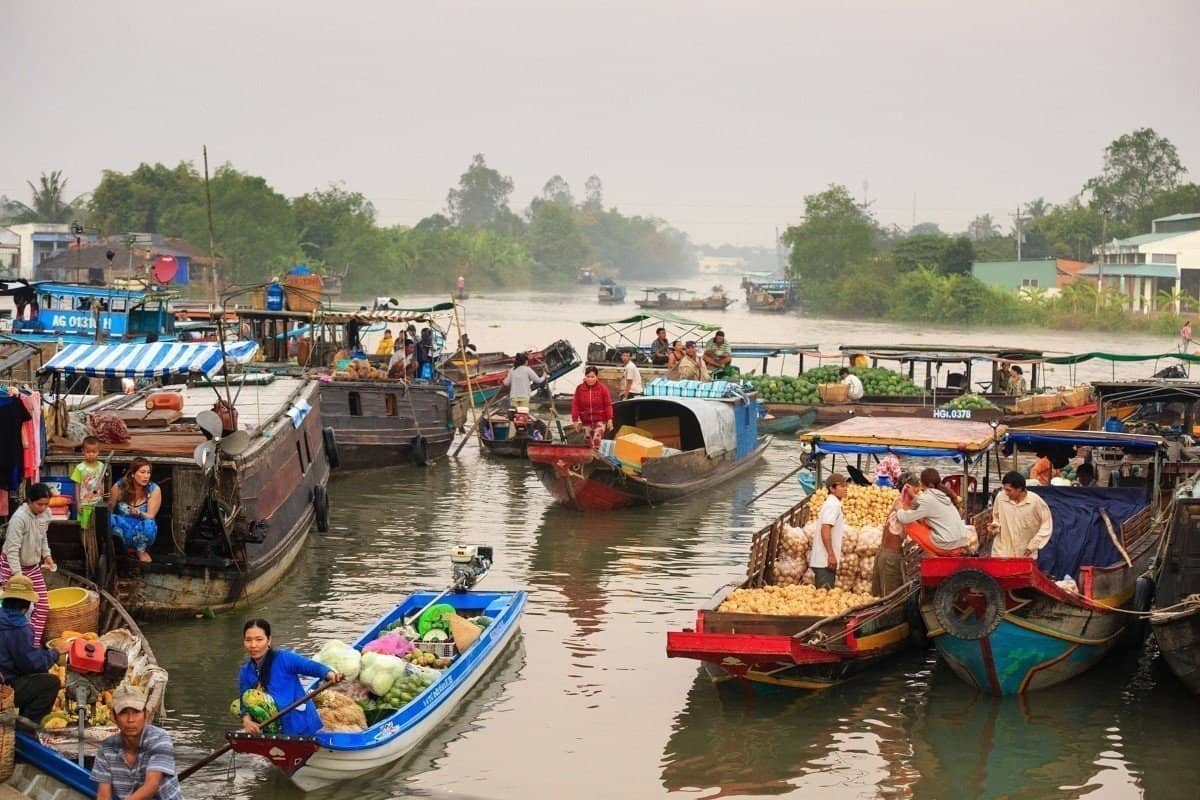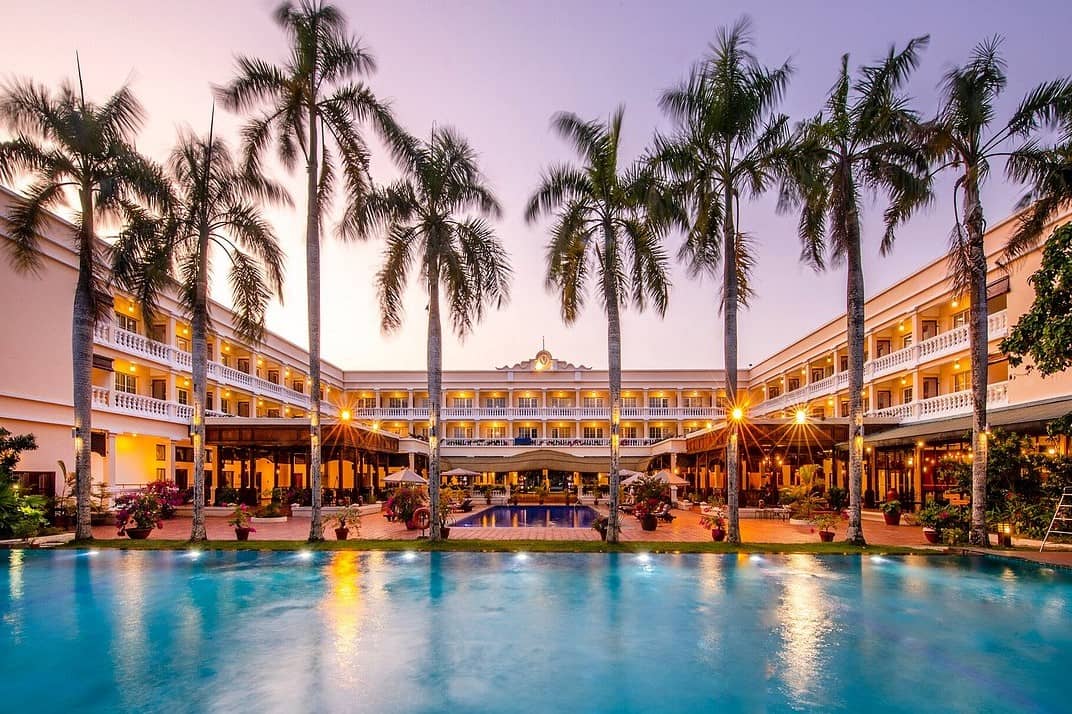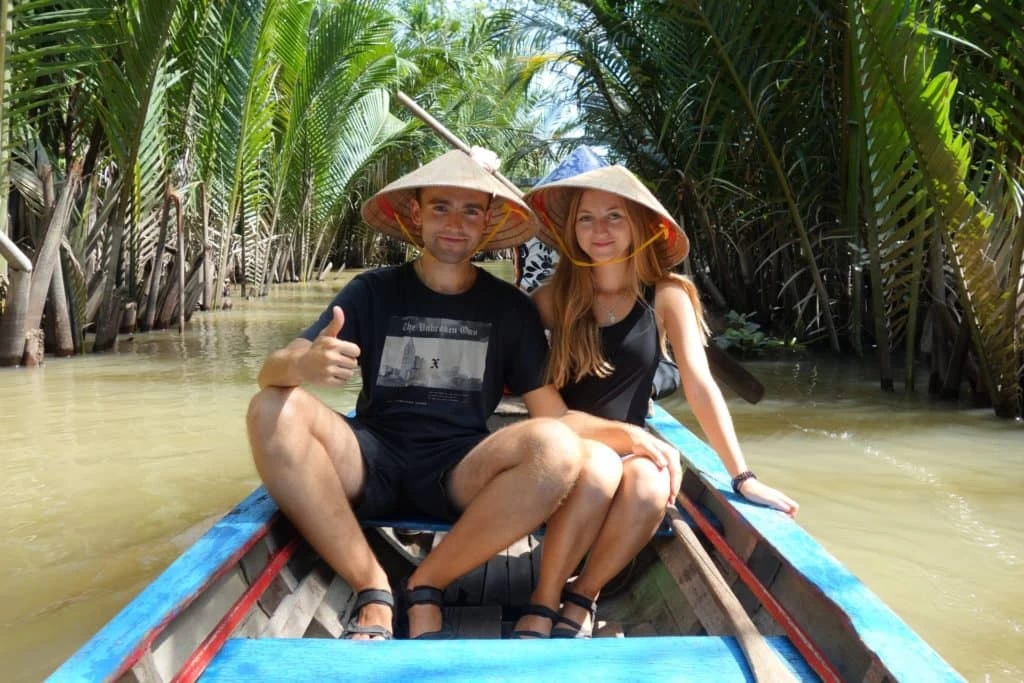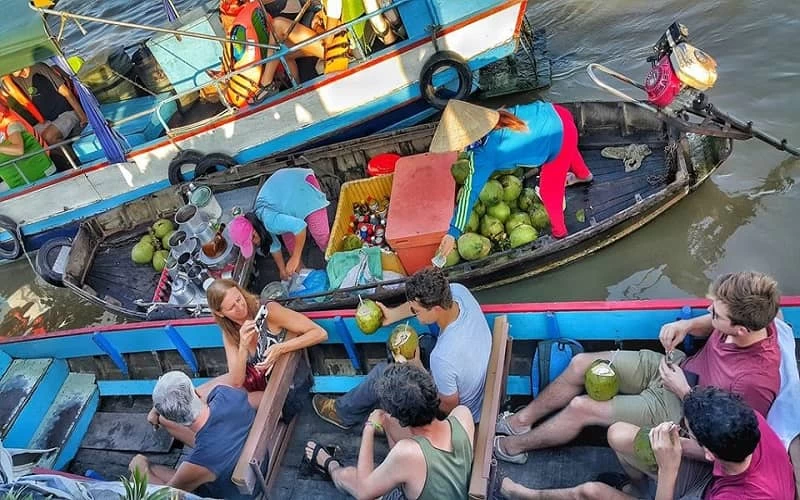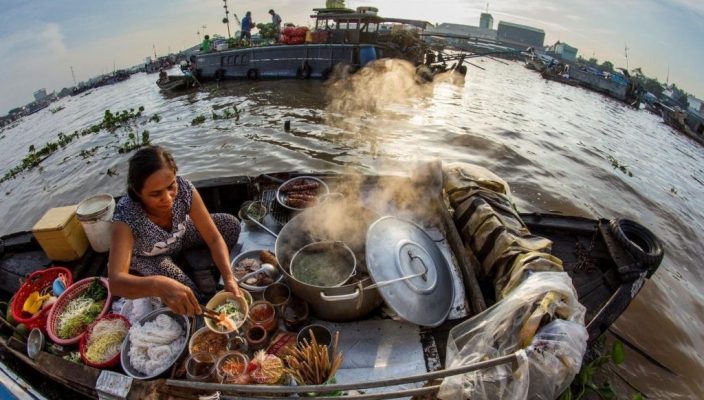
Let’s experience Mekong Delta cuisine
Mekong Delta cuisine offers a feast for the senses, blending flavors from land and water to create dishes that are as diverse as they are delicious. Whether you’re a seasoned foodie or an adventurous traveler, a culinary journey through the Mekong Delta promises unforgettable experiences and unforgettable flavors.
I. The Richness and Diversity of Mekong Delta Cuisine
One of the highlights of the Mekong Delta is its cuisine, which reflects the region’s abundance and diversity. The fertile lands and extensive waterways provide a wealth of fresh ingredients, including rice, fruits, vegetables, fish, and seafood. This availability of fresh produce has given rise to a culinary tradition that is both rich and varied, characterized by bold flavors, vibrant colors, and unique cooking techniques.
Mekong Delta cuisine is known for its emphasis on fresh herbs and vegetables, which are often used to balance the rich and savory flavors of the dishes. Some of the most famous dishes from the region include Banh Xeo (savory pancakes), grilled snakehead fish, and Bun Mam (fermented fish noodle soup). These dishes showcase the region’s culinary ingenuity and the influence of its diverse cultural heritage.
The delta is also renowned for its tropical fruits, such as durian, mangosteen, and rambutan, which are enjoyed fresh or used in various desserts and snacks. In addition, the traditional sweets, like Ben Tre coconut candy, highlight the local craftsmanship and the importance of coconut in the regional cuisine.
Overall, the Mekong Delta Cuisine is a reflection of its rich natural resources and the cultural melting pot that defines the region. It offers a unique and delightful culinary experience that captivates the senses and provides a deep insight into the local way of life.
Learn more about: All Mekong Delta Tours
II. 9 Signature Dishes of the Mekong Delta Cuisine
1. Banh Xeo (Vietnamese Savory Pancake)
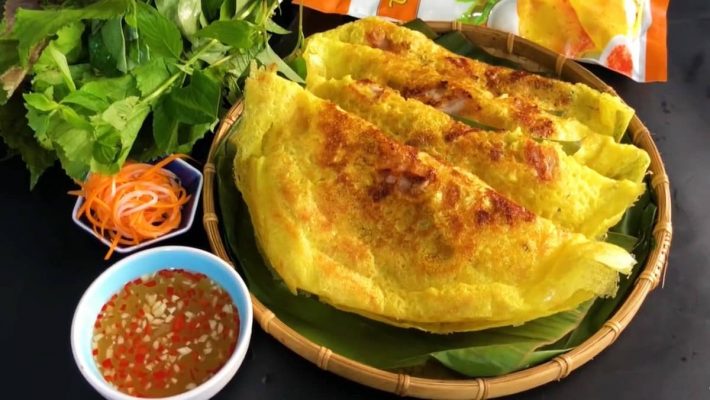
Banh Xeo
Banh xeo, often referred to as Vietnamese savory pancakes, are crispy crepes made from rice flour, turmeric, and coconut milk. Filled with succulent shrimp, thin slices of pork, and bean sprouts, they are served with a mountain of fresh herbs and lettuce. Diners wrap the pancakes in lettuce leaves and dip them in a tangy fish sauce.
Tips for tourists:
- Eating Method: Use your hands to wrap the banh xeo in lettuce for an authentic experience.
- Allergies: If you have shellfish allergies, ask for a version without shrimp.
Where to try:
- Banh Xeo My Phuong: 23B Nguyen Van Linh, Can Tho
- Banh Xeo Muoi Xiem: 13/3 Dong Binh Hamlet, Dong Thanh Commune, Binh Minh District, Vinh Long
- Price Range: $2-$4 per serving
2. Grilled Snakehead Fish
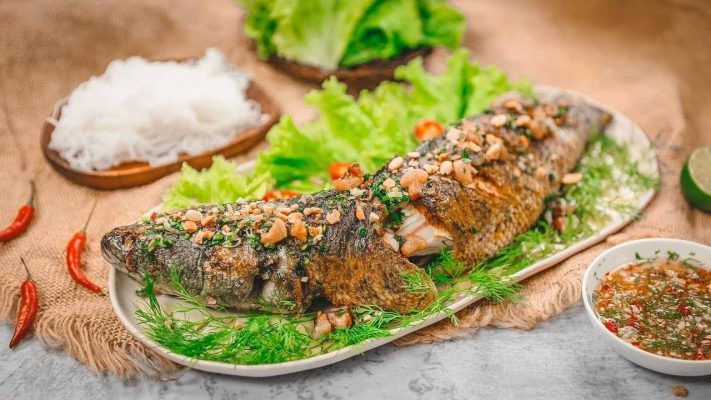
Grilled Snakehead Fish
This traditional dish involves grilling whole snakehead fish over an open flame, often on a bed of rice straw, which gives it a smoky flavor. The fish is typically served with rice paper, fresh herbs, and vermicelli noodles, allowing diners to create their own spring rolls at the table.
Tips for tourists:
- Preparation: The fish is served whole; don’t be intimidated. Ask the server to help with deboning if needed.
- Accompaniments: Pair with local beer for an enhanced flavor experience.
Where to try:
- Ms Ba restaurant: 123 April 30 Street, Can Tho
- Dat Phuong Nam restaurant: 1, 3/2 Street, Soc Trang City
- Price Range: $5-$8 per fish
Start your journey with: Mekong Delta Tour Package.
3. Bun Mam (Fermented Fish Noodle Soup)
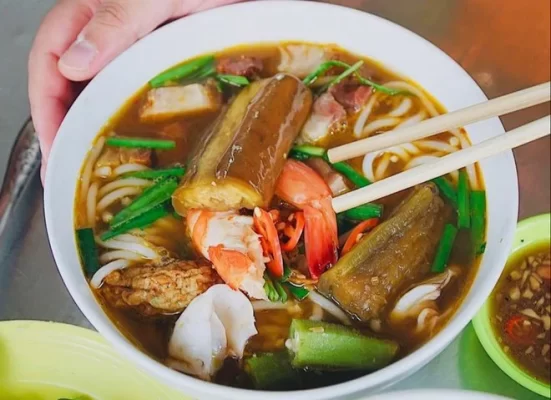
Fermented Fish Noodle Soup
Bun mam features a deeply flavorful broth made from fermented fish paste, giving it a strong, distinctive aroma. This hearty soup includes rice vermicelli, shrimp, squid, pork belly, and various vegetables, topped with fresh herbs like Vietnamese coriander and banana blossom.
Tips for tourists:
- Smell: The broth has a pungent aroma due to the fermented fish paste, which may be an acquired taste.
- Enhancements: Add a squeeze of lime and chili for extra zest.
Where to try:
- Bun Mam Sau: No.7 Le Loi, Ward 3, Can Tho
- Bun Mam 173–173 Nguyen An Ninh, Sa Dec City, Dong Thap
- Price Range: $3-$5 per bowl
4. Lau Mam (Fermented Fish Hotpot)
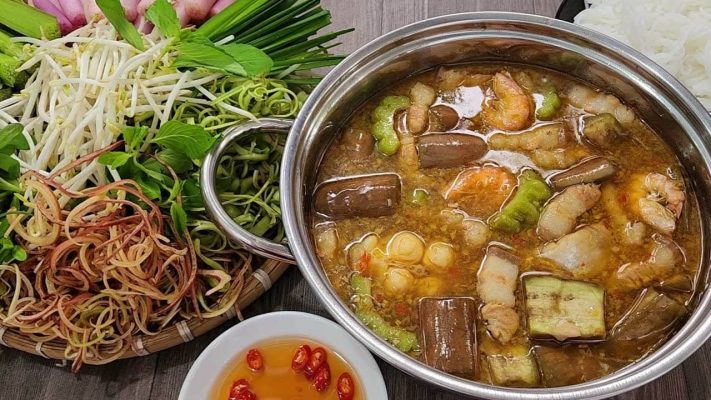
Fermented Fish Hotpot
Similar to bun mam, lau mam is a hotpot with a rich broth made from fermented fish paste. Diners cook their own ingredients, including seafood, meat, and vegetables, right at the table, making it a fun and interactive meal.
Tips for tourists:
- Sharing: This dish is ideal for groups; enjoy it with friends or family.
- Broth: Sip the broth sparingly at first to get accustomed to its strong flavor.
Where to try:
- Can Tho Fish Hot Pot – 162 Tran Hung Dao, Can Tho
- Ba Du Fish Sauce Hotpot – 86/3 Phan Dinh Phung, Soc Trang City
- Price Range: $10-$15 per pot (serves 2-4 people)
Do not miss: Best of Southern Vietnam
5. Goi Cuon (Fresh Spring Rolls)
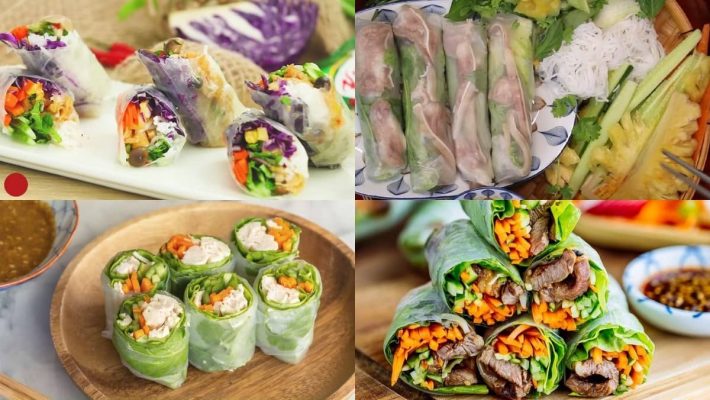
Fresh Spring Rolls
Goi cuon, or fresh spring rolls, are made with shrimp, pork, vermicelli noodles, and fresh herbs, all wrapped in delicate rice paper. These refreshing rolls are typically served with a peanut-dipping sauce or a hoisin-based sauce with crushed peanuts.
Tips for tourists:
- Dipping Sauce: Don’t skip the peanut sauce—it adds a delicious, nutty flavor.
- Make Your Own: Some restaurants offer DIY spring roll kits, which can be a fun activity.
Where to try:
- Thanh Phong Restaurant: 152 3/2 Street, Soc Trang City
- Goi Cuon Ba Nam, 45 Le Thi Hong Gam Street, Vinh Long City
- Price Range: $1-$2 per roll
You will be like: Discover A Glimpse of The Mekong Delta 2D1N
6. Hu Tieu My Tho (My Tho Rice Noodles)
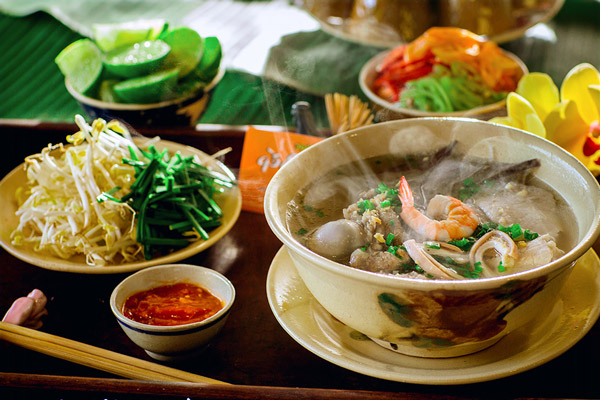
My Tho Rice Noodles
This noodle soup from My Tho is known for its clear, flavorful broth and chewy rice noodles. It is topped with an assortment of ingredients, such as sliced pork, shrimp, quail eggs, and liver, and garnished with chives, lettuce, and fried shallots.
Tips for tourists:
- Customization: Feel free to add chili, lime, or extra herbs to suit your taste.
- Beverage: Pair with a local iced coffee for a refreshing contrast.
Where to try:
- Uncle Ba’s Noodle Soup, 44 Nguyen Hue, My Tho City
- Noodle Soup 44 – 44A Tran Hung Dao, My Tho City
- Price Range: $2-$3 per bowl
7. Banh Tam Bi (Silkworm Noodles with Pork Skin)
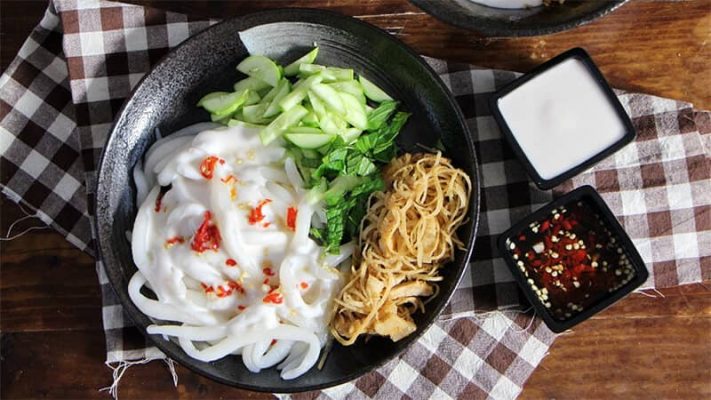
Banh Tam Bi
Banh tam bi features thick, chewy noodles resembling silkworms, topped with shredded pork skin, fresh herbs, and crushed peanuts. It is served with a sweet coconut milk sauce and a side of fish sauce.
Tips for tourists:
Sweetness: The coconut milk sauce adds a unique sweetness—don’t be surprised!
Mixing: Mix all the ingredients well to combine the flavors before eating.
Where to try:
- Banh Tam Bi Dong Thap: 1 Nguyen Hue, Cao Lanh City
- Banh Tam Bi Nam Truyen : 52 Dinh Tien Hoang, Sa Dec City
- Price Range: $1.50–$3 per plate
Let’s Discover The Ho Chi Minh City to Mekong Delta Tour!
8. Banh Pía (Durian Cake)
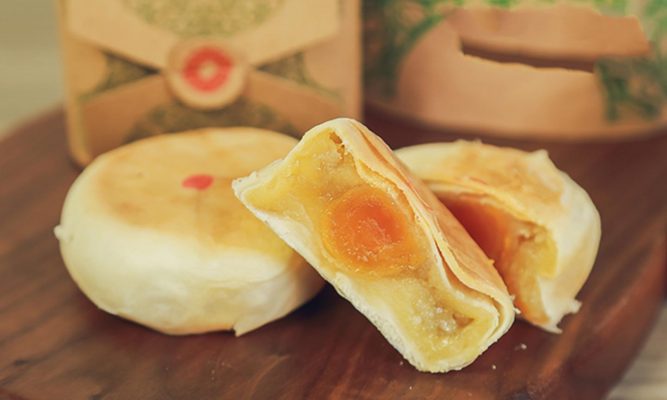
Banh Pía
Banh pía is a sweet pastry filled with durian paste, mung bean, and sometimes salted egg yolk. It has a flaky crust and a rich, creamy filling, making it a popular dessert or snack.
Tips for tourists:
- Durian: The durian filling has a strong smell and flavor; it’s an acquired taste.
- Storage: Keep it in a cool place, as the filling can spoil in hot weather.
Where to try:
- Tan Hue Vien Bakery, 80 National Highway 1, Soc Trang City
- Que Lo Apricot Sausage, 18 Le Loi Street, Soc Trang City
- Price Range: $1-$2 per cake
9. Tropical Fruits
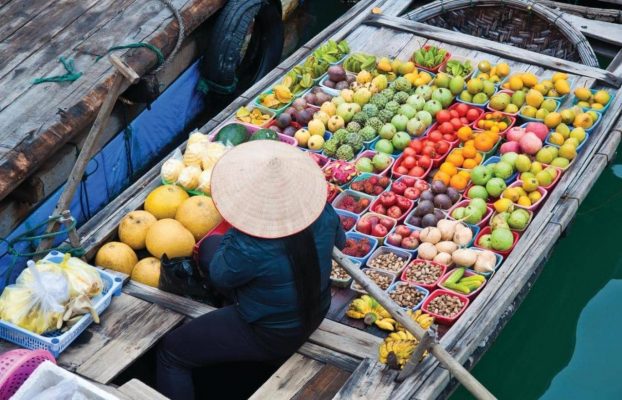
Tropical Fruits
The Mekong Delta is renowned for its abundant tropical fruits, such as durian, mangosteen, rambutan, and dragon fruit. These fruits are often enjoyed fresh, providing a refreshing and healthy treat.
Tips for tourists:
- Market Visit: Visit local markets early in the morning for the freshest selection.
- Sampling: Don’t hesitate to ask for samples before buying.
Where to try:
- Cai Be Floating Market, Cai Be, Tien Giang
- Vinh Long Fruit Garden, Vinh Long City
- Price Range: $1-$3 per fruit, depending on the type and size.
III. Unique Culinary Experiences of the Mekong Delta
1. Floating Markets
One of the most distinctive and memorable culinary experiences in the Mekong Delta is visiting the floating markets. These markets are a vibrant and dynamic showcase of local life and cuisine, bustling with activity and bursting with colors and aromas.
a. Cai Rang Floating Market
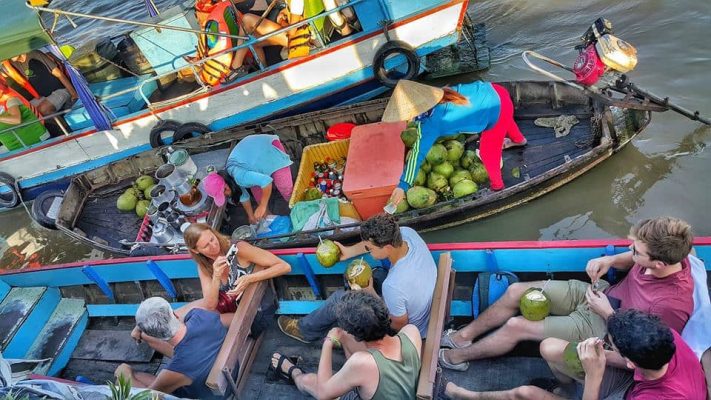
Cai Rang Floating Market
Cai Rang floating market, the largest and most famous market in the Mekong Delta, is located near Can Tho. It operates from the early hours of the morning until around noon.
Picture yourself gliding along the river on a boat as the sun rises, casting a golden hue over the water. The market is a hive of activity, with vendors selling a dazzling array of fresh fruits, vegetables, and other local products from their boats. The air is filled with the chatter of bargaining and the scent of tropical fruits.
Indulge in a steaming bowl of “hu tieu” (rice noodle soup) prepared right on the boat, or sip on a cup of aromatic Vietnamese coffee while floating on the river. The experience is immersive and offers a unique perspective on the daily lives of the locals.
Learn more about: Cai Rang Floating Market- The Latest Travel Guide 2024
b. Phong Dien Floating Market
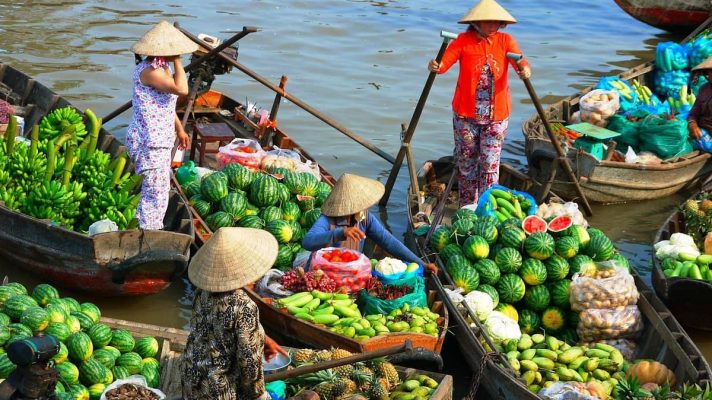
Phong Dien Floating Market
Phong Dien floating market is smaller and less touristy than Cai Rang, providing a more authentic and intimate experience.
This market comes alive in the early hours, around 4 AM, and winds down by 8 AM. As you navigate through the narrow channels, you’ll encounter boats laden with fresh produce and traditional snacks. The atmosphere is peaceful, allowing you to observe the simple, unhurried lifestyle of the local people.
Try the freshly made “banh mi” (Vietnamese baguette sandwiches) or “banh bao” (steamed buns) from the vendors. The early morning light and the tranquil surroundings create a picturesque setting for a truly memorable experience.
2. Culinary Tours
To truly immerse yourself in the flavors of the Mekong Delta, consider joining a culinary tour. These tours often combine food tasting with cultural experiences, offering a comprehensive insight into the region’s gastronomy.
a. Cooking Classes
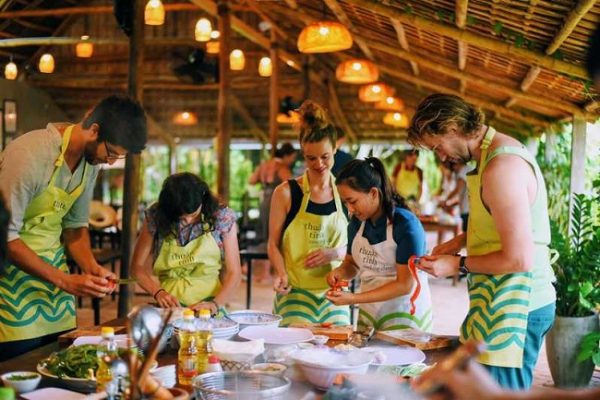
Taking cooking classes is a good way to experience Mekong Delta Cuisine
Many tours include cooking classes where you can learn to prepare traditional Vietnamese dishes using fresh, local ingredients.
Begin your culinary adventure with a visit to a bustling local market. Here, you’ll select the freshest ingredients, guided by a knowledgeable chef. The vibrant colors and diverse scents of the market are just the beginning. Back in the kitchen, you’ll roll up your sleeves and get hands-on experience preparing dishes like “gỏi cuốn” (spring rolls) or “cá kho tộ” (caramelized fish in a clay pot). The process is both educational and enjoyable, offering a deep dive into Vietnamese cooking techniques.
The satisfaction of creating delicious dishes from scratch, followed by the joy of savoring your culinary creations, provides a rich and rewarding experience. Cooking alongside locals adds a personal touch and offers a window into their daily lives and traditions.
b. Farm Visits and Fruit Picking
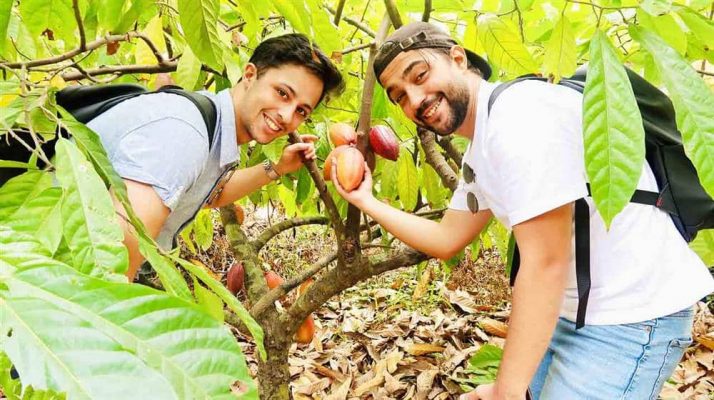
Farm visits and fruit picking
The Mekong Delta is renowned for its abundant fruit orchards. Many tours include visits to these lush orchards, where you can pick and taste fresh fruits right from the trees.
Imagine strolling through verdant orchards filled with tropical fruits like durian, mangosteen, and longan. The air is fragrant with the scent of ripe fruit, and the trees are heavy with colorful, juicy produce. Farmers will guide you, sharing insights into the cultivation and harvesting processes.
There’s nothing quite like the taste of fresh fruit plucked straight from the tree. The experience is both delicious and educational, as you learn about the diverse varieties of fruits and their importance in Vietnamese cuisine. The lush, green environment also offers a peaceful retreat from the hustle and bustle of urban life.
3. Local Dining Experiences
a. Homestay Meals
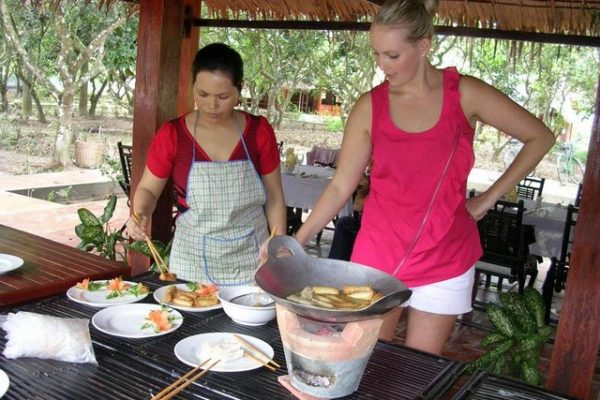
Local homestay offers a unique opportunity to experience home-cooked meals
Staying in a local homestay offers a unique opportunity to experience home-cooked meals and learn about the everyday lives of the residents.
At a homestay, you’re welcomed into a Vietnamese family’s home, where meals are a communal and joyous affair. Hosts prepare dishes using ingredients from their gardens or local markets. Meals are served family-style, allowing you to sample a variety of dishes while engaging in lively conversations with your hosts and fellow guests.
Enjoy traditional dishes like “lẩu mắm” (fermented fish hotpot) or “canh chua cá lóc” (sour snakehead fish soup) in an intimate, familial setting. The warmth and hospitality of your hosts, along with their personal stories and cultural insights, enrich the dining experience and create lasting memories.
b. Riverside Restaurants
Dining at riverside restaurants offers scenic views and a peaceful ambiance, complementing the delicious local cuisine.
Many of these restaurants are perched on stilts above the river, providing stunning views of the water and surrounding landscape. As you dine, you can enjoy the gentle river breeze and the soothing sounds of the flowing water. The menu often features fresh seafood prepared in a variety of traditional ways.
The combination of delectable food, the picturesque setting, and the tranquil atmosphere makes for an unforgettable dining experience, especially at sunset when the sky is painted with hues of orange and pink.
By exploring these unique culinary experiences, visitors not only savor the diverse and rich flavors of the Mekong Delta but also gain a deeper understanding of the region’s culture and traditions. Whether navigating bustling floating markets, participating in hands-on cooking classes, or enjoying a meal at a local homestay, the culinary journey through the Mekong Delta is sure to be an enriching and memorable adventure.
IV. Tips for Ensuring Safety When Enjoying Mekong Delta Cuisine
- Look for Busy Stalls: A good rule of thumb for street food safety is to eat at stalls that are popular with locals. High turnover means fresher ingredients and a better reputation for cleanliness.
- Observe Hygiene Practices: Pay attention to the cleanliness of the vendor and their equipment. Vendors who handle food with gloves, use clean utensils, and have a tidy preparation area are generally safer choices.
- Choose Cooked Foods: Opt for food that is cooked to order. High heat kills most pathogens, making hot dishes safer than raw or pre-prepared options.
Choosing Reputable and Hygienic Places:
- Research and Reviews: Before dining out, especially at new places, check reviews and ratings online. Many travelers and locals leave feedback about hygiene standards and food quality.
- Recommendations: Ask for recommendations from locals or trusted sources like hotel staff or tour guides. They can point you to reputable eateries known for their cleanliness and delicious food.
In conclusion, The Mekong Delta cuisine offers a rich tapestry of flavors and traditions that captivate the senses and intrigue the palate. From the crispy delights of Banh Xeo to the savory depths of Bun Mam, each dish tells a story of the land and its people, steeped in centuries of tradition and innovation.
We encourage you to embark on a culinary adventure through the Mekong Delta, indulging in these tantalizing dishes for an unforgettable gastronomic experience. Whether you’re exploring bustling markets, savoring street food delights, or dining in local eateries, every bite offers a glimpse into the vibrant culture and heritage of this enchanting region.
See more: Mekong Delta travel tips



